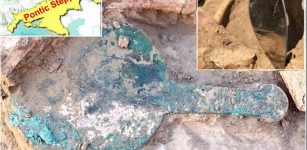Nippur – Holy City Of God Enlil And One Of The Oldest Cities Of Sumer
A. Sutherland - AncientPages.com - Nippur (Sumerian: Nibru, "Enlil City"; Akkadian: Nibbur) was among the most ancient Sumerian cities and one of the most important religious centers throughout Mesopotamia. Some researchers date back the city's creation to about 5000 BC.
In the 4th millennium BC the temple of the Sumerian wind god Enlil at Nippur in present Iraq was a famous pilgrimage center. The rectangular palace atop the ancient ziggurat dates from the Parthian period and is thus thousands of years younger. Omage credit: David Stanley - CC BY 2.0
Throughout the history of Sumer, Nippur - located northeast of the town of Ad-Diwaniyah, now in southeastern Iraq - had a special place among the cities.
Based on the earliest existing records, it is known that Nippur was not a capital but a sacred city, a central and unique shrine of the region. Its holy character helped Nippur survive several wars and the fall of dynasties that destroyed other cities.
Nippur was the seat of Enlil, the chief god of the Sumerian pantheon, the "Lord Wind," ruler of the cosmos, and one of the triads of gods, including Anu (Sumerian: An) and Ea (Sumerian: Enki). The city - located halfway between Ur and Sippar - also played a significant political role.
Based on the earliest existing records, it is known that Nippur was not a capital but a sacred city, a central and unique shrine of the region. Its holy character helped Nippur survive several wars and the fall of dynasties that destroyed other cities.
Nippur, Temple of Bel excavation, 1896. Hilprecht, H. V. (Hermann Vollrat), 1859-1925 - Old Babylonian inscriptions. Published 1896 - Public Domain
Kings were involved in the city's restoration of temples, construction of fortification walls, public administrative buildings, and canals. Even after 1800 BC., when the Babylonians made Marduk the most critical god in southern Mesopotamia, Enlil was still worshiped and had his sanctuary. Nippur remained a holy and prestigious city, with over a hundred temples, regardless of which dynasty ruled Mesopotamia.
Probably because of its strategic location and sacred meaning, it remained a neutral city.
Cuneiform tablet from Nippur, in the name of Shar-Kali-Sharri, 2300–2100 BC. Image credit: Mary Harrsch - CC BY 2.0
Nippur's most significant growth occurred under the Ur III kings (c. 2100 BC). It was almost matched in the time of the Kassites (c. 1250 BC.) and when the Assyrians from northern Iraq dominated Babylonia (c. 750-612 BC).
The first mention of Nippur is related to the construction of a temple dedicated to Enlil. It was erected during the reign of King Enmebaragesi, a king of Kish, according to the Sumerian king list. The list states that he subdued Elam and reigned for 900 years.
Enmebaragesi dominated Sumer around the year 2700 BC and also controlled Nippur. Little is known about the prehistoric city of Nippur, but by 2500 BC, the city expanded, was fortified, and probably reached the extent of the present remains.
In about 2450 BC, the city became part of the empire of Eannatuma of Lagash. About 2430 BC, Nippur was conquered by Enshakushanna, a king of Uruk in the later 3rd millennium BC, who, according to the Sumerian King List, reigned for 60 years.
Babylonian cuneiform tablet with a map from Nippur, Kassite period, 1550–1450 BC. Image credit: Mary Harrsch - flickr.com - CC BY 2.0
About .2300 BC, Sargon's Akkadian empire controlled the city, and around the year 2230 BC, Sargon's grandson - Naram-Sin - under the influence of the temple's oracle, attacked Enlil in Nippur. As a result, there was a meeting of the eight most essential gods, who withdrew their support for the king; the city's inhabitants began to suffer from hunger.
With the collapse of the Sumerian civilization and Ur about 2000 BC, Nippur was briefly occupied by the Elamites and later incorporated into the Amorite kingdom of Isin.
The remains of the Nippur, which today are named Nuffar, were excavated in 1851 and during different periods, namely in 1888 - 1900 and 1948 – 1990.
In the city's eastern part, the so-called 'scribal quarter,' archaeologists unearthed several thousands of Sumerian tablets, with economic, linguistic, and many examples of the Sumerian literary texts. Most of them were found in the archives in two private homes.
Another part of the city was the 'sacred area' with the temple complex and a ziggurat called E-kur (in its present form), where construction works were performed by the first kings of the Third Dynasty of Ur - Ur-Nammu and Shulgi (2094–2047).
In one of the trenches, archaeologists discovered two prominent temples; one was the temple of Inanna, goddess of love and war, one of the most important deities in the Mesopotamian pantheon, and another, the Temple of the North – the remains of the palace, the temple library, which provided 20 thousand tablets and tombs, where the dead were buried after partial burning.
The excavation conducted in 1990 revealed an Akkadian tomb and a large temple to Bau (Gula), the Mesopotamian goddess of healing and medicine, whose special symbol was a dog.
Among various artifacts were several figurines of dogs found on floors and buried in the plaster on walls; fragmentary figures of human beings having pain; one with his hand to his throat, another with one hand to his head, and one to his stomach.
Written by A. Sutherland - AncientPages.com Staff Writer
Updated on January 16, 2024
Copyright © AncientPages.com All rights reserved. This material may not be published, broadcast, rewritten or redistributed in whole or part without the express written permission of AncientPages.com
Expand for referencesKramer Samuel Noah. N. The Sumerians
Kriwaczek, Paul. Babylon: Mesopotamia and the Birth of Civilization
More From Ancient Pages
-
 Remarkable Ancient Windcatchers: Air Conditioning Systems Built Since Antiquity
Ancient Technology | Sep 3, 2016
Remarkable Ancient Windcatchers: Air Conditioning Systems Built Since Antiquity
Ancient Technology | Sep 3, 2016 -
 Mysterious Lost Civilization Of Tiahuanaco – Uncomfortable Truth About One Of The World’s Oldest Cities
Civilizations | May 24, 2020
Mysterious Lost Civilization Of Tiahuanaco – Uncomfortable Truth About One Of The World’s Oldest Cities
Civilizations | May 24, 2020 -
 Two Giant Limestone Sphinxes Of Pharaoh Amenhotep III And A Statue Of Goddess Sekhmet Discovered In Luxor
Archaeology | Aug 11, 2022
Two Giant Limestone Sphinxes Of Pharaoh Amenhotep III And A Statue Of Goddess Sekhmet Discovered In Luxor
Archaeology | Aug 11, 2022 -
 Remarkable Ancient Animal Engravings Discovered In Unknown Cave In Sinai
Archaeology | May 1, 2020
Remarkable Ancient Animal Engravings Discovered In Unknown Cave In Sinai
Archaeology | May 1, 2020 -
 Riddle Of Two Undeciphered Elamite Scripts
Featured Stories | May 19, 2021
Riddle Of Two Undeciphered Elamite Scripts
Featured Stories | May 19, 2021 -
 Investigation Of A 2.9-Million-Year-Old Site Reopens Case Of Who Made First Stone Tools
Archaeology | Feb 9, 2023
Investigation Of A 2.9-Million-Year-Old Site Reopens Case Of Who Made First Stone Tools
Archaeology | Feb 9, 2023 -
 Colors On These Ancient Pots Hint At The Power Of An Empire
Archaeology | Mar 7, 2023
Colors On These Ancient Pots Hint At The Power Of An Empire
Archaeology | Mar 7, 2023 -
 Scythians Were Not Always Nomadic Warriors Of The Pontic Steppe In Black Sea Region
Archaeology | Mar 19, 2021
Scythians Were Not Always Nomadic Warriors Of The Pontic Steppe In Black Sea Region
Archaeology | Mar 19, 2021 -
 Draken Harald Hårfagre – World’s Largest Viking Ship On Its Way To U.S And Canada
News | Apr 27, 2016
Draken Harald Hårfagre – World’s Largest Viking Ship On Its Way To U.S And Canada
News | Apr 27, 2016 -
 Unusual Stone Carvings And Medieval ‘Witching’ Marks To Ward Off Evil Spirits Discovered In England
Archaeology | Oct 29, 2020
Unusual Stone Carvings And Medieval ‘Witching’ Marks To Ward Off Evil Spirits Discovered In England
Archaeology | Oct 29, 2020 -
 Skull From Broken Hill, Zambia Is Relatively Young – New Analysis Shows
Fossils | Apr 2, 2020
Skull From Broken Hill, Zambia Is Relatively Young – New Analysis Shows
Fossils | Apr 2, 2020 -
 Vikings May Have Made Imitation Gold Dinar Found In Morston, Norfolk – Expert Says
Archaeology | Apr 5, 2023
Vikings May Have Made Imitation Gold Dinar Found In Morston, Norfolk – Expert Says
Archaeology | Apr 5, 2023 -
 Svantevit – Four-Headed War God Of The Slavic Peoples Of Central Europe
Featured Stories | Sep 13, 2015
Svantevit – Four-Headed War God Of The Slavic Peoples Of Central Europe
Featured Stories | Sep 13, 2015 -
 6,300 Years Old Golden Artifact Unearthed At Solnitsata ‘The Salt Pit’ Prehistoric Settlement
Archaeology | Nov 23, 2015
6,300 Years Old Golden Artifact Unearthed At Solnitsata ‘The Salt Pit’ Prehistoric Settlement
Archaeology | Nov 23, 2015 -
 Why Do Old Norse Myths Endure In Popular Culture?
Featured Stories | Mar 16, 2023
Why Do Old Norse Myths Endure In Popular Culture?
Featured Stories | Mar 16, 2023 -
 Gold Spiral In Early Bronze Age Grave – Unearthed
Archaeology | Jun 1, 2021
Gold Spiral In Early Bronze Age Grave – Unearthed
Archaeology | Jun 1, 2021 -
 Secret Ancient Powers Of Jade: Sacred Green Healing Stone That Can Conquer Time And Guarantee Immortality
Artifacts | Oct 1, 2016
Secret Ancient Powers Of Jade: Sacred Green Healing Stone That Can Conquer Time And Guarantee Immortality
Artifacts | Oct 1, 2016 -
 The Black Obelisk Of Shalmaneser III – Great Assyrian Ruler
Artifacts | Dec 29, 2016
The Black Obelisk Of Shalmaneser III – Great Assyrian Ruler
Artifacts | Dec 29, 2016 -
 Untold Story Of Mexico’s Ancient Giant Indians – Secret Knowledge Of The Aztecs Revealed – Part 1
Featured Stories | Sep 21, 2019
Untold Story Of Mexico’s Ancient Giant Indians – Secret Knowledge Of The Aztecs Revealed – Part 1
Featured Stories | Sep 21, 2019 -
 Extraordinary Discovery Of ‘Time Capsule’ Belonging To Jules Verne – It May Contain Unpublished Works
Archaeology | Apr 19, 2017
Extraordinary Discovery Of ‘Time Capsule’ Belonging To Jules Verne – It May Contain Unpublished Works
Archaeology | Apr 19, 2017




